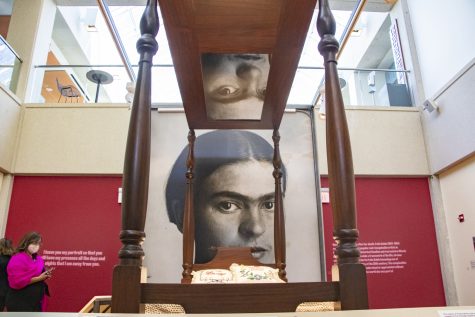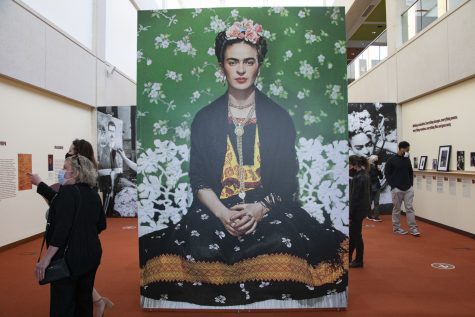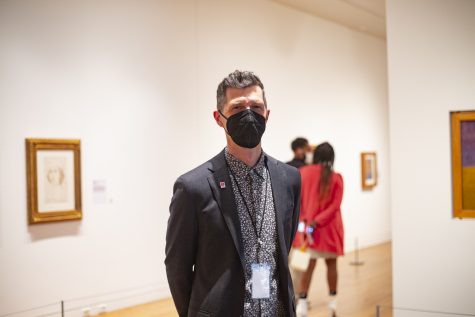Former Columbia faculty member curates largest collection of Frida Kahlo’s work
June 7, 2021

The “Frida Kahlo: Timeless” exhibit now open at the College of DuPage allows viewers to first walk through a timeline of Kahlo’s life and then into a gallery of deeply emotional and intentional paintings.
The exhibit includes more than two dozen of her most famous works such as “La Columna Rota,” which translates to “The Broken Column,” and “Retrato de Luther Burbank,” meaning “Portrait of Luther Burbank.”
The largest collection of Frida Kahlo paintings in the world came to the College of DuPage’s Cleve Carney Museum of Art, 425 Fawell Blvd., Glen Ellyn, Illinois, as a loan from the Museo Dolores Olmedo in Mexico City. The exhibit opened to the public June 5 and will be available for viewing until Sept. 6.
Justin Witte, exhibition curator of the Cleve Carney Museum of Art and curator of “Frida Kahlo: Timeless” with associate curator Marcella Andrade, told Kahlo’s story by including historical context and photographs of Kahlo’s life before displaying the paintings themselves, which he said is unlike many contemporary exhibitions that display Kahlo’s paintings next to various objects and photos.
“Because the paintings are the only things we really have that Frida made to tell her story, I really wanted to present them in a way where she could tell her story clearly and without interruption,” Witte said.

Witte formerly taught as an adjunct faculty member and worked in the Department of Exhibitions, Performance and Student Spaces at Columbia from 2008 to 2015, teaching in the foundations program and curating Columbia’s Glass Curtain Gallery in 2015, among other work.
“So much of what prepared me for it was my time working at Columbia; it’s a fantastic institution that’s forever shaped who I am,” Witte said.
Debra Parr, associate professor in the Art and Art History Department, has known Witte for years and remembers interviewing and hiring Witte when she was the associate chair for the department.
Parr said she thinks Kahlo’s work may be more relevant now than ever.
“I think that [Kahlo] anticipates a lot of questions around the body, around gender, around identity, that we are very much interested in today,” Parr said. “I think that in some sense the world today is much more prepared to understand Kahlo and love her and love her paintings.”
After learning about her life in chronological order, including her childhood, the horrific bus accident that disabled her at 18 years old, her relationship with Diego Rivera and her involvement with the Mexican Communist Party, viewers are able to observe 26 of Kahlo’s detailed paintings, reflecting themes of pain, politics, the cycle of life and death, and beauty.
The exhibit also includes original photographs of Kahlo’s life, along with replicas of her bed and the Indigenous Mexican clothing she wore, a miniature model of “La Casa Azul,” a children’s activity area, a gift shop and an additional exhibit called “Tres Fridas,” which showcases work from three Chicago-based artists with spinal injuries who take inspiration from Kahlo’s artwork.

Because Kahlo is so well known, Witte said he wants people attending the exhibit to learn something new about Kahlo.
“It’s easy sometimes to overlook the actual work she made because people have a preconceived idea of who she was and what it is that she created,” Witte said.
Adriana Jaramillo, international exhibitions coordinator for the Museo de Dolores Olmedo, worked with the College of DuPage and the Cleve Carney Museum of Art to coordinate the logistics of the exhibition.
Jaramillo said the international exhibits of the Kahlo collection planned for last year were postponed to this year due to the pandemic. She said after the collection’s time at the Cleve Carney Museum of Art, it will travel to the Drents Museum in Assen, Netherlands.
Jaramillo said because Kahlo’s art is Mexican national patrimony, the Museo de Dolores Olmedo has to request a temporary export permit in order for the paintings to leave Mexico. The paintings can be away for a maximum of 24 months before returning to Mexico and exhibited there for six months to one year before they can travel again.

Jaramillo described the “Frida Kahlo: Timeless” exhibit as a “holistic view of Frida’s life and work” and said it has many unique aspects, including a special installation of “Retrato de Virgina (Nina),” or “Portrait of Virgina (Little Girl),” which has a pencil sketch of Kahlo on the back.
Witte said “Frida Kahlo: Timeless” has changed the profile of the Cleve Carney Museum of Art and their expectations for the future.
“I think in this moment we’re all living in, coming out of the pandemic, coming out of such a tumultuous year, to come together to share the story of someone who so bravely and unapologetically faced the challenges of her life is a perfect way to celebrate this,” Witte said.







